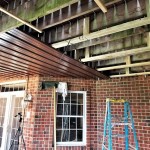Is a Vaulted Ceiling the Same as a Cathedral?
Vaulted ceilings and cathedral ceilings both feature upwardly curved surfaces, creating a sense of height and grandeur in a space. However, there are some key differences between these two ceiling types that distinguish their architectural styles.
Structural Elements
The primary difference between a vaulted ceiling and a cathedral ceiling lies in their structural elements. Vaulted ceilings are constructed using a series of curved arches or ribs that create a framework for the ceiling's form. These ribs may intersect to form a variety of patterns, including groin vaults and ribbed vaults. On the other hand, cathedral ceilings are characterized by their pointed, triangular shape. They are typically supported by a series of vertical beams or trusses that run upwards and meet at a central point.
Height
Generally, cathedral ceilings are taller than vaulted ceilings. This is because cathedral ceilings have a pointed apex that extends higher into the space, while vaulted ceilings tend to have a flatter, more rounded shape. The height of a ceiling can significantly impact the overall ambiance of a room, with taller ceilings creating a more dramatic and spacious atmosphere.
Historical Context
Cathedral ceilings originated in medieval cathedrals and were designed to evoke a sense of awe and reverence within religious spaces. Vaulted ceilings, on the other hand, have a longer architectural history, dating back to ancient Roman times. Vaulted ceilings were commonly used in palaces, temples, and other important buildings, where they showcased the skill and ingenuity of the architects who constructed them.
Architectural Style
Vaulted ceilings and cathedral ceilings are associated with distinct architectural styles. Vaulted ceilings are often found in Romanesque and Gothic buildings, characterized by their heavy, stone construction and rounded arches. Cathedral ceilings, as their name suggests, are most commonly associated with Gothic architecture, known for its pointed arches, ribbed vaults, and towering spires.
Variations
Within each ceiling type, there are further variations to consider. Barrel vaults are a type of vaulted ceiling with a single, continuous arch that spans the width of the space. Dome vaults create a hemispherical shape, while cross vaults are formed by the intersection of two barrel vaults at a right angle. Similarly, cathedral ceilings can vary in their shape and the number of points they feature. Some cathedral ceilings have a single, central point, while others may have multiple ribs or trusses radiating from a central boss.
Conclusion
While vaulted ceilings and cathedral ceilings share some similarities in their upwardly curved surfaces, they are distinct architectural elements with unique structural characteristics, historical contexts, and architectural styles. Understanding the differences between these ceiling types can enhance your appreciation of both their aesthetic and functional qualities in architectural design.

Cathedral Ceilings Vs Vaulted What S The Difference

Vaulted Ceilings Vs Cathedral

Ceilings Vaulted Or Cathedral Drummond House Plans Blog

Vault Architecture Wikipedia

Solving Cathedral Vaulted Ceiling Problems

Vaulted Ceilings Vs Cathedral

Cathedral Ceilings Vs Vaulted

All About Cathedral Ceilings Ideas Inspiration And The Latest Trends Home Like You Mean It

A Complete Guide To Vaulted Ceiling Types Merits Demerits

Problem Ceilings That Could Definitely Wreck Your Room Laurel Home
Related Posts








